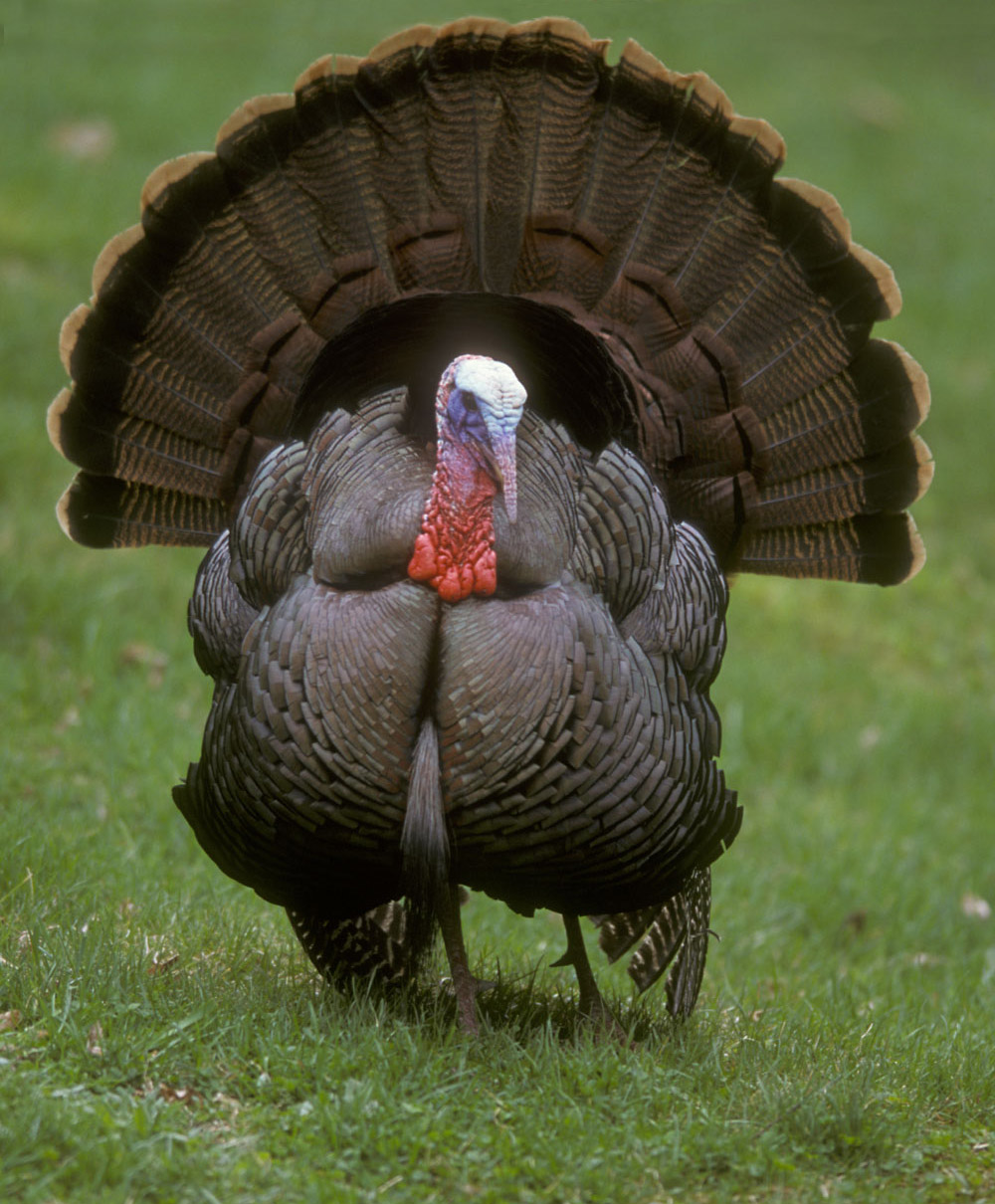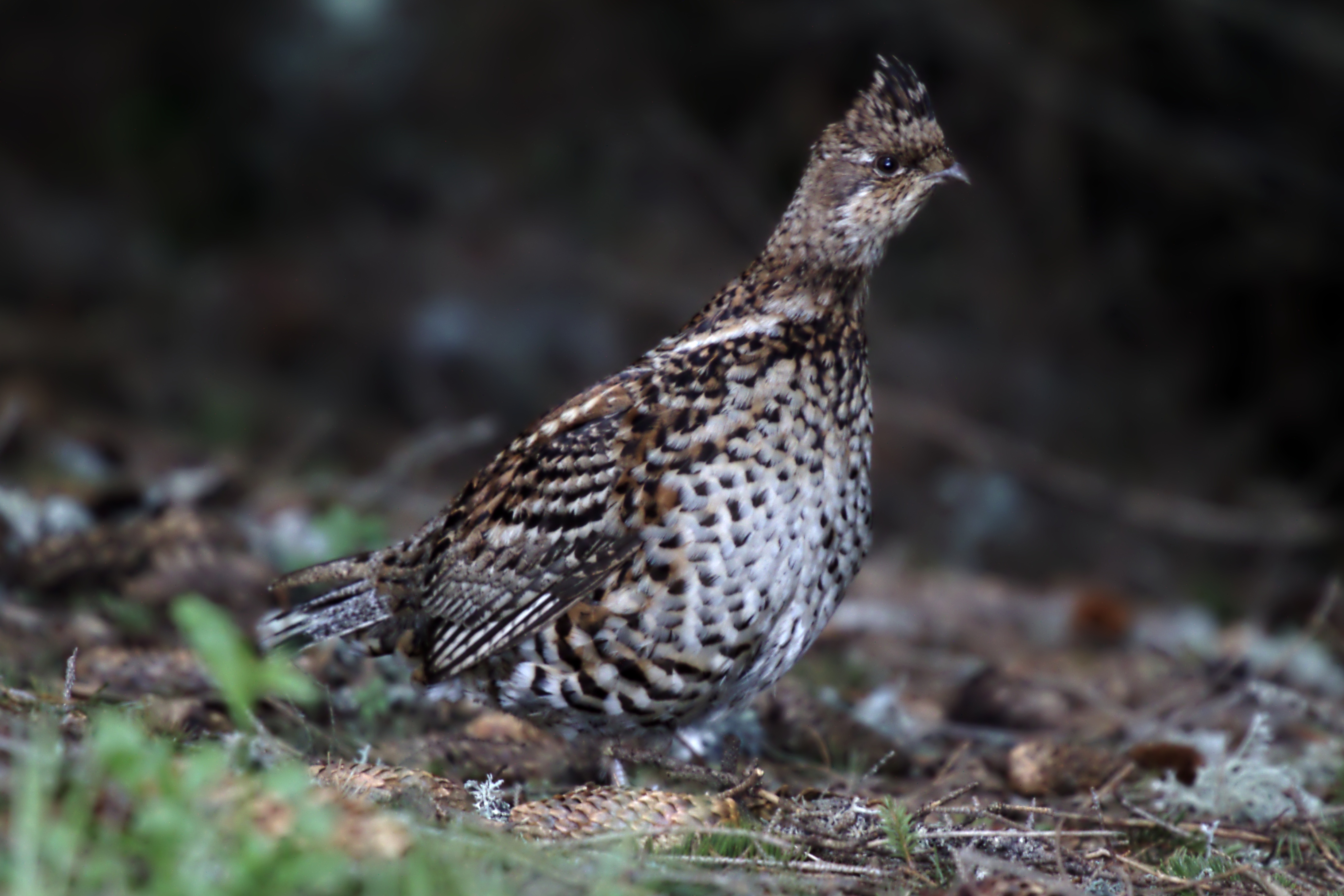|
Grouse
Grouse are a group of birds from the order (biology), order Galliformes, in the family (biology), family Phasianidae. Grouse are presently assigned to the Tribe (biology), tribe Tetraonini (formerly the subfamily Tetraoninae and the family Tetraonidae), a classification supported by mitochondrial DNA sequence studies, and applied by the American Ornithologists' Union, ITIS, International Ornithologists' Union, International Ornithological Congress, and others. Grouse inhabit temperate and subarctic regions of the Northern Hemisphere, from pine trees, pine forests to moorland and mountainside, from 83rd parallel north, 83°N (rock ptarmigan in northern Greenland) to 28th parallel north, 28°N (Attwater's prairie chicken in Texas). The Turkey (bird), turkeys are closely allied with grouse, but they have traditionally been excluded from Tetraonini, often placed in their own tribe, subfamily, or family; certain more modern treatments also exclude them. Later phylogenomic analyses ... [...More Info...] [...Related Items...] OR: [Wikipedia] [Google] [Baidu] [Amazon] |
Bonasa Umbellus Male 253270687
The ruffed grouse (''Bonasa umbellus'') is a medium-sized grouse occurring in forests from the Appalachian Mountains across Canada to Alaska. It is the most widely distributed game bird in North America. It is bird migration, non-migratory. It is the only species in the genus ''Bonasa''. The ruffed grouse is sometimes incorrectly referred to as a "partridge", an unrelated Phasianidae, phasianid, and occasionally confused with the grey partridge, a bird of open areas rather than woodlands. The ruffed grouse is the List of U.S. state birds, state game bird of Pennsylvania, United States. Taxonomy ''Bonasa umbellus'' was first described by Carl Linnaeus in his 1766 12th edition of Systema Naturae, 12th edition of ''Systema Naturae''. He classified it as ''Tetrao umbellus'', placing it in a subfamily with Eurasian grouse. The genus ''Bonasa'' was applied by British naturalist John Francis Stephens in 1819. Ruffed grouse is the preferred common name because it applies only to this ... [...More Info...] [...Related Items...] OR: [Wikipedia] [Google] [Baidu] [Amazon] |
Centrocercus
Sage-grouse are grouse belonging to the bird genus ''Centrocercus.'' The genus includes two species: the Gunnison grouse (''Centrocercus minimus'') and the greater sage-grouse (''Centrocercus urophasianus''). These birds are distributed throughout large portions of the north-central and Western United States, as well as the Canadian provinces of Alberta and Saskatchewan. The International Union for Conservation of Nature classified the ''C. minimus'' species as endangered in 2020 and ''C. urophasianus'' as near threatened in 2016. Names The specific epithet is from another Greek word, "oura", plus "phasianos", pheasant. The noun "pheasant" was originally applied to a bird that was native to the valley of the Phasis River (now the Rioni River), which is located in Georgia. In the time of Lewis and Clark the word "pheasant" stood for "a genus of gallinaceous birds", according to lexicographer Noah Webster (1806), and the explorers often used it in that sense. "Gallinaceous" the ... [...More Info...] [...Related Items...] OR: [Wikipedia] [Google] [Baidu] [Amazon] |
Phasianidae
Phasianidae is a family (biology), family of heavy, ground-living birds, which includes pheasants, grouse, partridges, junglefowl, chickens, Turkey bird, turkeys, Old World quail, and peafowl. The family includes many of the most popular Game (hunting), gamebirds. The family includes 185 species divided into 54 genera. It was formerly broken up into two subfamily (biology), subfamilies, the Phasianinae and the Perdicinae. However, this treatment is now known to be paraphyly, paraphyletic and polyphyly, polyphyletic, respectively, and more recent evidence supports breaking it up into two subfamilies: Rollulinae and Phasianinae, with the latter containing multiple Tribe (biology), tribes within two clades. The New World quail (Odontophoridae) and guineafowl (Numididae) were formerly sometimes included in this family, but are now typically placed in families of their own; conversely, grouse and turkey (bird), turkeys, formerly often treated as distinct families (Tetraonidae and Melea ... [...More Info...] [...Related Items...] OR: [Wikipedia] [Google] [Baidu] [Amazon] |
Dendragapus
The genus ''Dendragapus'' contains two closely related species of grouse that have often been treated as a single variable taxon (blue grouse). The two species are the dusky grouse (''Dendragapus obscurus'') and the sooty grouse (''Dendragapus fuliginosus''). In addition, the spruce grouse and Siberian grouse have been considered part of this genus. Description These are large grouse that inhabit highland regions of North America and Eurasia. The sooty grouse is found in the Pacific Coast Ranges and Sierra Nevada (U.S.), Sierra Nevada, and the dusky grouse in the Rocky Mountains. These two taxa were originally regarded as separate species, but were considered conspecific for much of the twentieth century. However, in 2006 the American Ornithologists' Union re-split them, following the DNA-based work of Barrowclough et al. (2004). whose results supported the earlier work of Brooks (1929) who regarded the two taxa as separate species based on morphology, behavior and vocalizati ... [...More Info...] [...Related Items...] OR: [Wikipedia] [Google] [Baidu] [Amazon] |
Falcipennis
The Siberian grouse (''Falcipennis falcipennis''), also known as Siberian spruce grouse, Amur grouse, or Asian spruce grouse, is a short, rotund forest-dwelling grouse. A sedentary, non-migratory bird, it is the only member of the genus ''Falcipennis''. The spruce grouse of North America, which physically looks similar, is now placed in the monotypic genus '' Canachites''. Description Adults measure around . Males weigh at , while females weigh . Both sexes are intricately speckled white on the belly, flanks, and undertail coverts with white streaks on the wing coverts and rump, plus a white terminal band at the tail tip. Males have sooty brownish-grey feathers with a ruff around its neck and a black bib outlined in white with red skin above each eye. Females are more pale brown in color and lack the distinct facial markings of the male. Distribution and habitat The Siberian grouse is distributed across eastern Siberia and the Russian Far East in the federal districts of Primors ... [...More Info...] [...Related Items...] OR: [Wikipedia] [Google] [Baidu] [Amazon] |
Galliformes
Galliformes is an order (biology), order of heavy-bodied ground-feeding birds that includes turkey (bird), turkeys, chickens, Old World quail, quail, and other landfowl. Gallinaceous birds, as they are called, are important in their ecosystems as seed dispersers and predators, and are often reared by humans for their meat and eggs, or hunted as game birds. The order contains about 290 species, inhabiting every continent except Antarctica, and divided into five Family (biology), families: Phasianidae (including chicken, quail, partridges, pheasants, turkeys, peafowl (peacocks) and grouse), Odontophoridae (New World quail), Numididae (guinea fowl), Cracidae (including chachalacas and curassows), and Megapodiidae (incubator birds like malleefowl and Brushturkey, brush-turkeys). They adapt to most environments except for innermost deserts and perpetual ice. Many gallinaceous species are skilled runners and escape predators by running rather than flying. Males of most species a ... [...More Info...] [...Related Items...] OR: [Wikipedia] [Google] [Baidu] [Amazon] |
Lagopus
''Lagopus'' is a genus of birds in the grouse subfamily commonly known as ptarmigans (). The genus contains four living species with numerous described subspecies, all living in tundra or cold upland areas. Taxonomy and etymology The genus ''Lagopus'' was introduced by the French zoologist Mathurin Jacques Brisson in 1760 with the willow ptarmigan (''Lagopus lagopus'') as the type species. The genus name ''Lagopus'' is derived from Ancient Greek (), meaning "hare, rabbit", + (), "foot", in reference to the feathered feet and toes typical of this cold-adapted group (such as the snowshoe hare). The Specific name (zoology), specific epithets ''muta'' and ''leucura'' were for a long time misspelt ''mutus'' and ''leucurus'', in the erroneous belief that the ending of ''Lagopus'' denotes grammatical gender, masculine gender. However, as the Ancient Greek term is of feminine gender, and the specific epithet has to agree with that, the feminine ''muta'' and ''leucura'' are correct. ... [...More Info...] [...Related Items...] OR: [Wikipedia] [Google] [Baidu] [Amazon] |
Lyrurus
''Lyrurus'' is a genus of birds in the grouse subfamily. They are known as black grouse because the male's plumage of both species is colored black as its base colour. Taxonomy The genus ''Lyrurus'' was introduced in 1832 by the English naturalist William Swainson with the black grouse as the type species. The genus name combines the Ancient Greek Ancient Greek (, ; ) includes the forms of the Greek language used in ancient Greece and the classical antiquity, ancient world from around 1500 BC to 300 BC. It is often roughly divided into the following periods: Mycenaean Greek (), Greek ... ''lura'' meaning "lyre" with ''-ouros'' meaning "-tailed". Species The genus contains two species: References Bird genera Birds of Eurasia Taxa named by William Swainson {{Galliformes-stub ... [...More Info...] [...Related Items...] OR: [Wikipedia] [Google] [Baidu] [Amazon] |
Tympanuchus
''Tympanuchus'' is a small genus of birds in the grouse family. They are commonly referred to as prairie-chickens. Taxonomy The genus ''Tympanuchus'' was introduced in 1841 by the German zoologist Constantin Wilhelm Lambert Gloger for the greater prairie chicken. The name combines the Ancient Greek ''tumpanon'' meaning "kettle-drum" with ''ekhō'' meaning "to have". The genus contains three species: All three are among the smaller grouse, from in length. They are found in North America in different types of prairie. In courtship display on leks, males make hooting sounds and dance with the head extended straight forward, the tail up, and colorful neck sacks inflated (shown in the photograph at upper right). ''Tympanuchus'' comes from Ancient Greek Ancient Greek (, ; ) includes the forms of the Greek language used in ancient Greece and the classical antiquity, ancient world from around 1500 BC to 300 BC. It is often roughly divided into the following period ... [...More Info...] [...Related Items...] OR: [Wikipedia] [Google] [Baidu] [Amazon] |
Tetrastes
''Tetrastes'' is a genus of birds in the grouse subfamily. It contains the following species: Both species live in forests with at least some conifer Conifers () are a group of conifer cone, cone-bearing Spermatophyte, seed plants, a subset of gymnosperms. Scientifically, they make up the phylum, division Pinophyta (), also known as Coniferophyta () or Coniferae. The division contains a sin ...s in cool regions of the Northern Hemisphere. References Bird genera Taxa named by Alexander von Keyserling Taxa named by Johann Heinrich Blasius {{Galliformes-stub ... [...More Info...] [...Related Items...] OR: [Wikipedia] [Google] [Baidu] [Amazon] |



